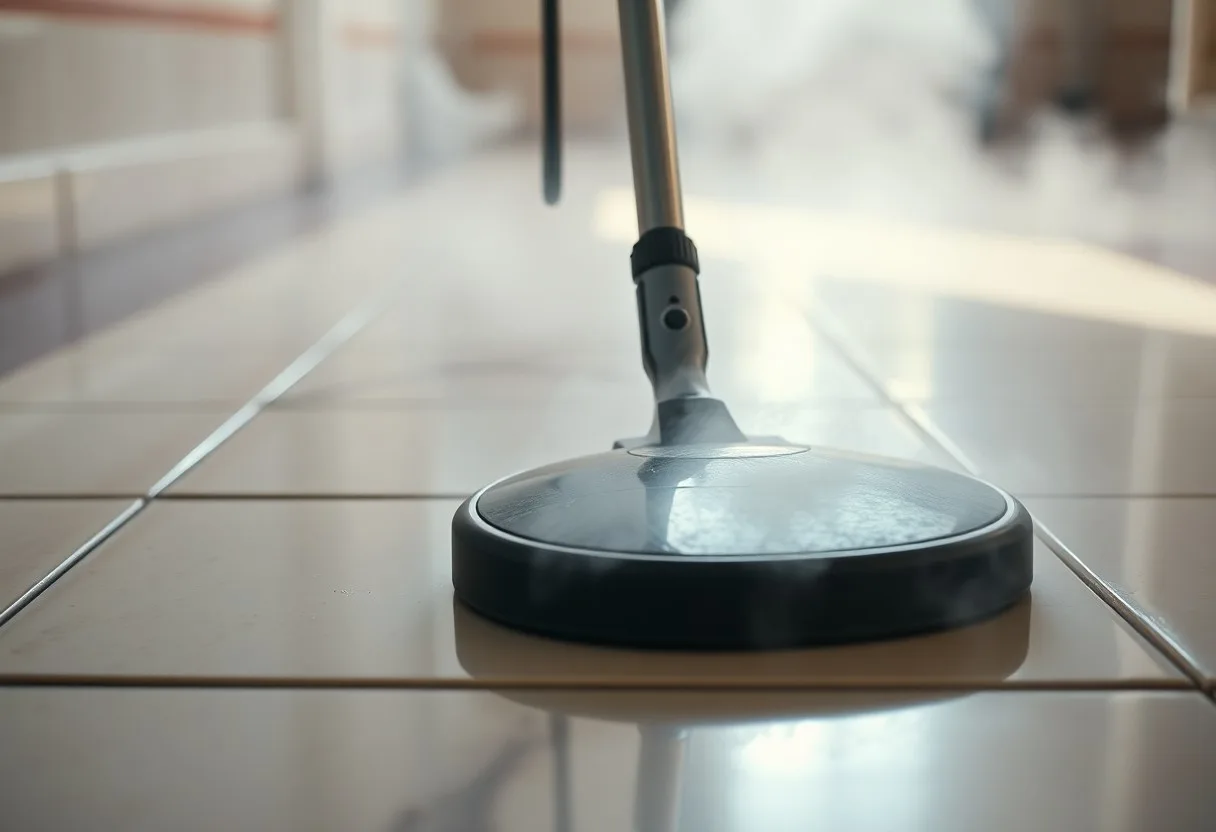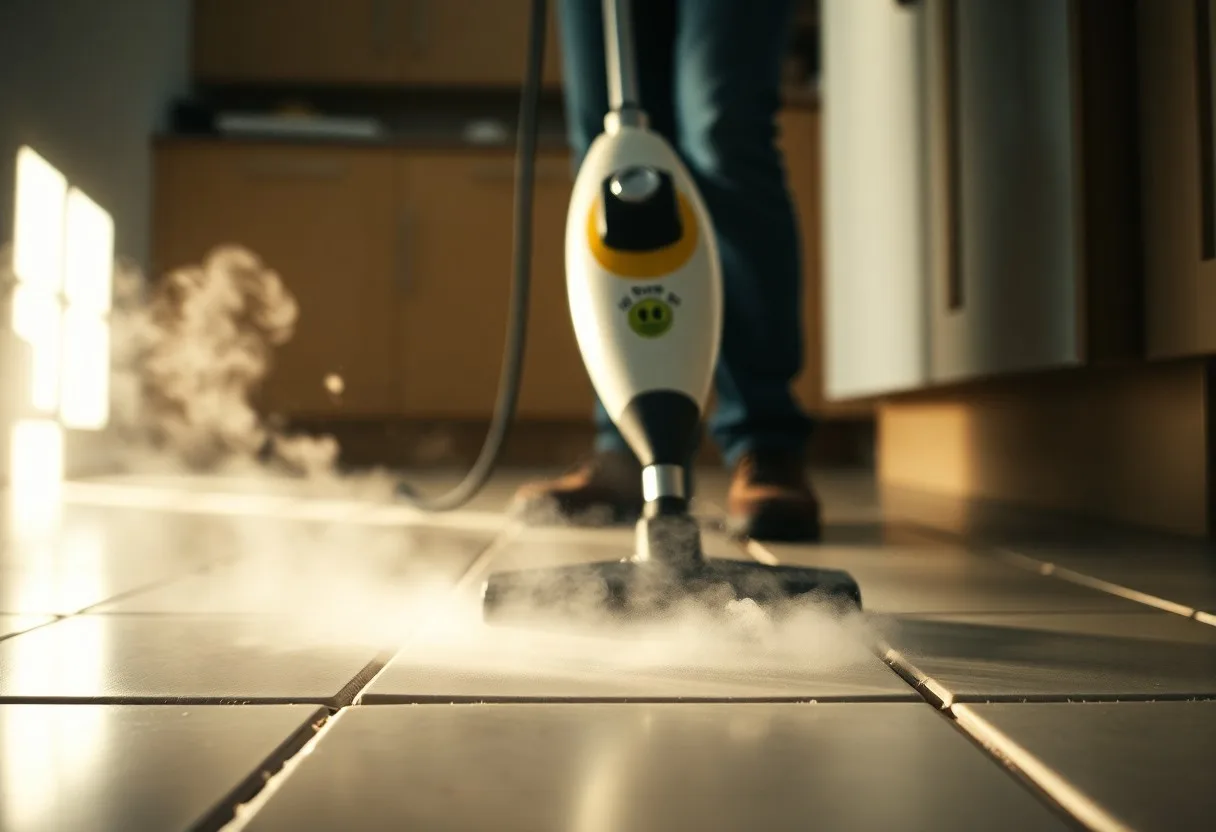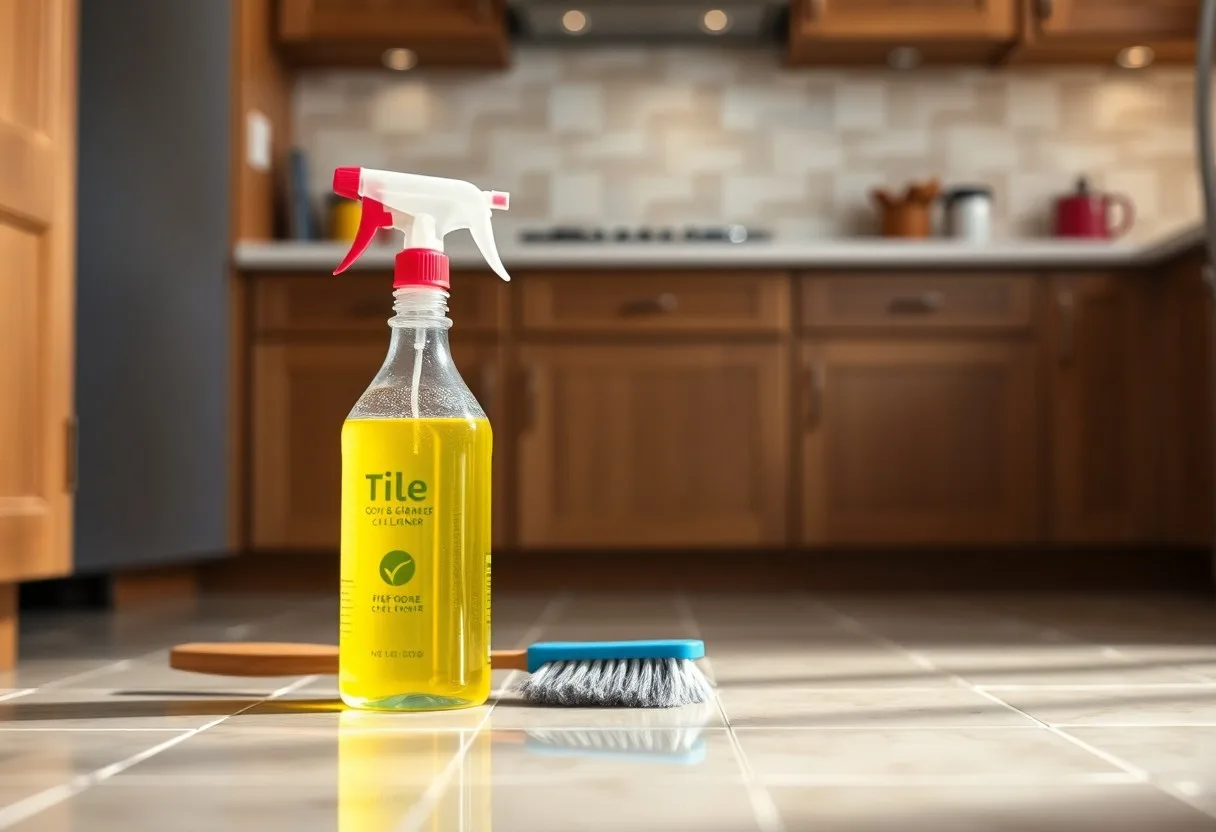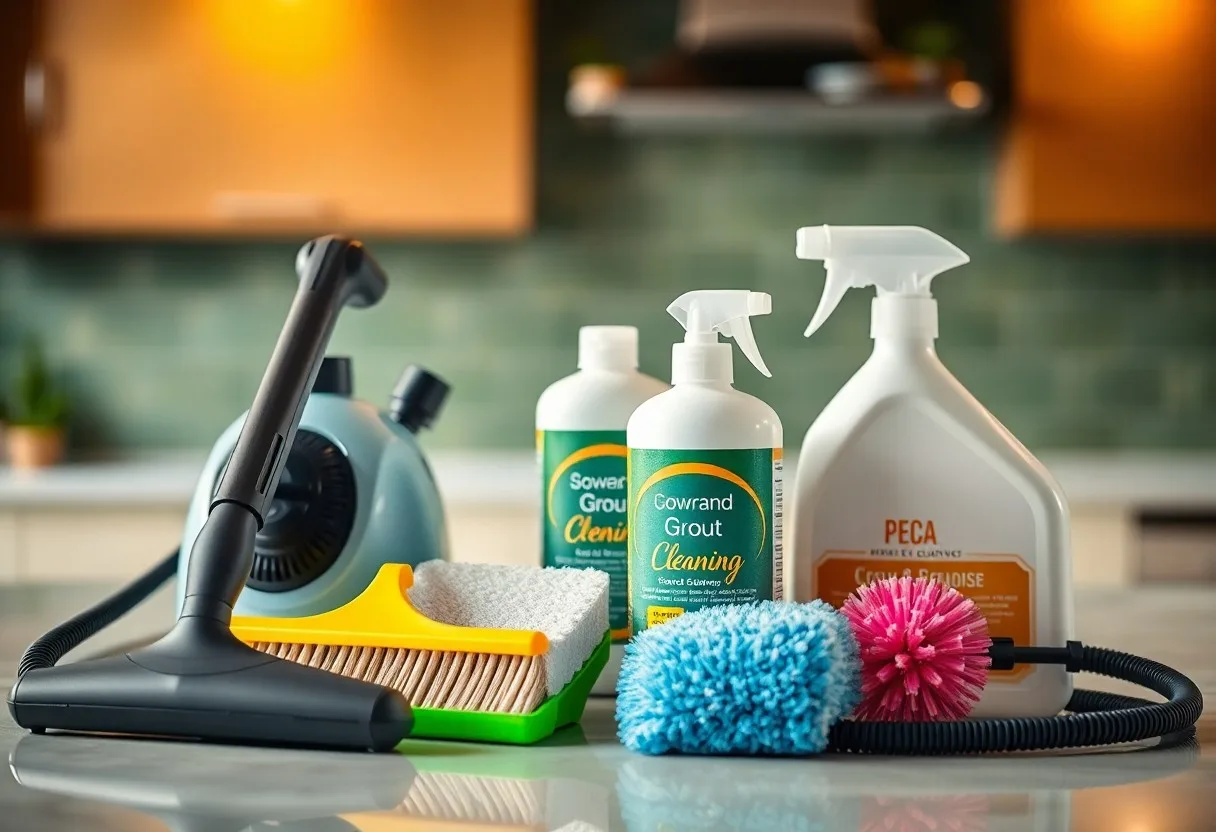How-To – Steam Cleaning Tile And Grout. Just envision the transformation of your tiled surfaces with a deep, professional clean that removes grime and restores shine! This guide will teach you how to effectively steam-clean tile and grout, achieving impressive results without harsh chemicals. Equip yourself with tips and techniques that ensure a spotless finish and keep your home safe and healthy. For more in-depth information on eco-friendly methods, check out this resource on How To Steam Clean Tile And Grout – Chemical Free. Let’s get started!
Key Takeaways:
- Preparation is crucial; sweep or vacuum the tile and grout to remove loose dirt before steam cleaning.
- Utilize the right steam cleaner attachments and settings to effectively tackle tough stains and dirt buildup.
- Regular steam cleaning can help maintain the appearance of your tile and grout, prolonging its lifespan and preventing extensive cleaning later on.
DIY Guide: Steam Cleaning Tile And Grout For A Spotless Shine 1. Gather the steam cleaner, attachments, and cleaning solution, if needed. 2. Sweep or vacuum floors to remove loose dirt. 3. Fill the steam cleaner with water and heat it up. 4. Test steam on a small area to adjust pressure. 5. Steam clean tiles, working in small sections systematically. 6. Wipe down surfaces with a microfiber cloth for shine.
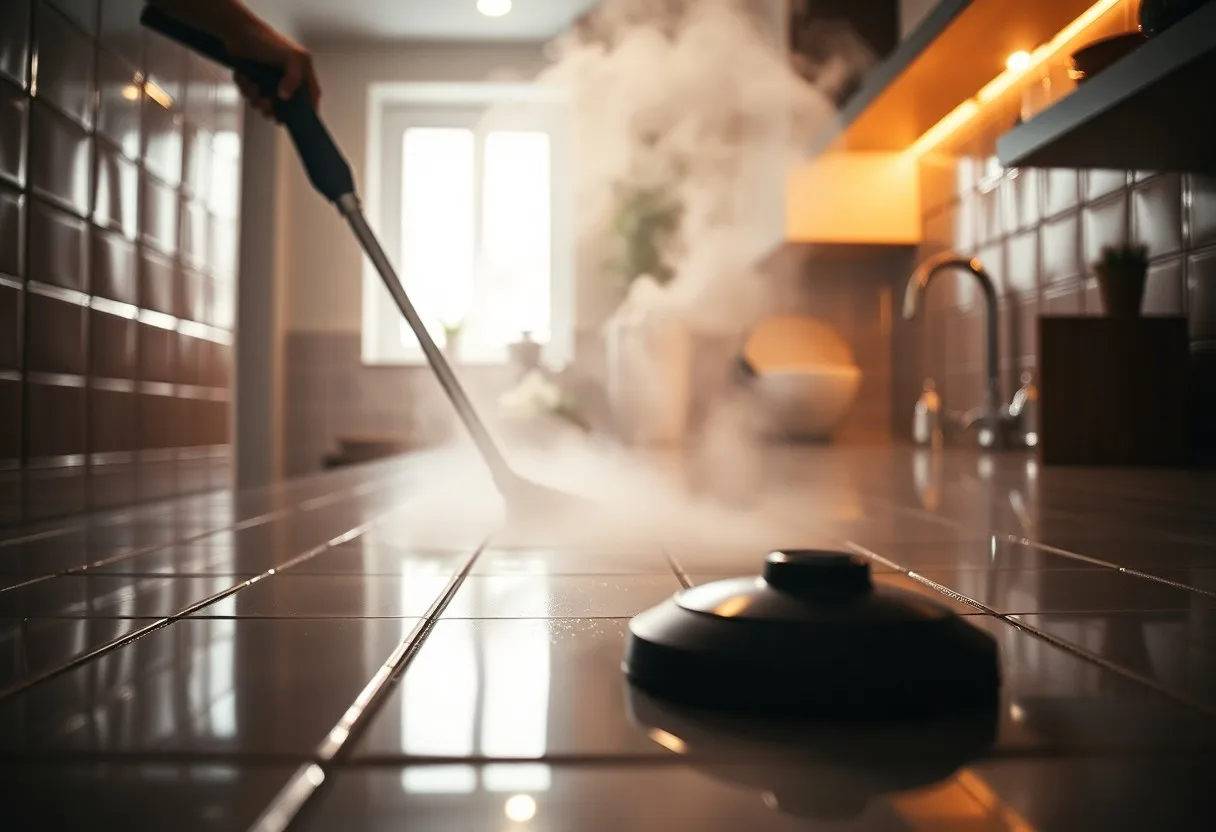
Understanding Tile and Grout
Understanding the types of tile and grout is important for maintaining a pristine home. Each material has unique characteristics, making it important to choose the right one for your specific needs and preferences.
Types of Tile
- Ceramic – Durable and versatile, ideal for various spaces.
- Porcelain – Denser and less porous than ceramic, perfect for moisture-prone areas.
- Natural Stone has unique aesthetics but requires more maintenance.
- Vinyl – Budget-friendly and easy to install, but less durable.
- Glass – Stylish and reflective, great for accents.
After exploring these options, you can better determine what works best for your home.
| Type | Features |
| Ceramic | Durable, versatile, easy to clean |
| Porcelain | Less porous and suitable for moisture-prone areas |
| Natural Stone | Unique looks require more care |
| Vinyl | Budget-friendly, easy installation |
| Glass | Stylish, reflective surfaces for accents |
Importance of Grout
Understanding the importance of grout is vital for maintaining tile surfaces. Grout is a binder for the tiles, filling the gaps and ensuring stability.
It acts as a protective barrier against moisture, dirt, and bacteria buildup, keeping your tiled areas looking fresh. Additionally, damaged or cracked grout can lead to serious issues like water damage and mold growth, posing significant risks to your health and property. Therefore, proper maintenance and timely repairs of your grout can keep your home not only looking clean but also safe. Always make sure your grout lines are intact to prevent costly repairs in the future.
Preparing for Steam Cleaning
Some simple preparations can make your steam-cleaning process smooth and efficient. Start by clearing the area of any furniture and items that may obstruct your work. Sweeping or vacuuming the floor will remove debris, allowing the steam cleaner to perform effectively on your tile and grout. Lastly, ensure that your steam cleaner is accessible and ready for use, checking that it is properly filled with water and has all necessary attachments on hand.
Tools and Equipment Needed
To achieve the best results, you’ll need a reliable steam cleaner, preferably with a grout-cleaning attachment. Microfiber cloths, a mop, and a bucket should also be nearby. A broom or vacuum cleaner for initial debris removal is also helpful. Having the right tools on hand will streamline your cleaning process.
Safety Considerations
Some important safety precautions should be observed to prevent accidents during steam cleaning. Always follow the manufacturer’s instructions for your steam cleaner and avoid using it on surfaces that are not recommended. Ensure your working area is free from water and debris to prevent slips and falls.
Equipment safety is paramount. Hot steam can cause serious burns, so ensure you keep your hands and face away from the steam nozzle during operation. Always wear long sleeves and closed-toe shoes to minimize skin exposure. Additionally, avoid using a steam cleaner on electrical appliances or outlets, as this can create a fire hazard. By taking these precautions, you can ensure a safe and efficient cleaning experience.
Step-by-Step Steam Cleaning Process
Despite the challenges of tackling dirty tiles and grout, following a systematic approach can lead to a spotless shine. Begin by gathering your steam-cleaning supplies and preparing your workspace. Then, move through each step methodically for optimal results. Below is a simplified outline of the process to guide you through steam cleaning effectively.
Process Overview
| Step | Action |
| 1 | Pre-Cleaning and Vacuuming |
| 2 | Steam Cleaning Techniques |
| 3 | Post-Cleaning Care |
| 4 | Regular Maintenance |
Pre-Cleaning and Vacuuming
Assuming your tiles have accumulated dirt and debris, start by sweeping or vacuuming the area thoroughly. This step is important as it removes loose particles that could scratch your tiles or become mud when steam cleaning. Make sure to also pay attention to the corners and edges, as grime tends to accumulate there.
Steam Cleaning Techniques
Clearly, the effectiveness of your steam cleaning largely depends on the techniques you use. Focus on sections of tile and grout methodically rather than working in broad strokes. Use the appropriate attachment for your steam cleaner and allow the steam to penetrate the surface for maximum cleaning efficiency.
With the right approach, steam cleaning becomes a powerful way to refresh your floors. Start by applying steam directly to the surface, holding the nozzle about an inch away from the tile. Use a rubbing motion to work the grime out of the grout lines. Use caution with your steam cleaner, as the steam can reach temperatures that may cause burns. Aim for a consistent motion across the tiles to prevent excess moisture buildup, which can affect your floors negatively. Following these techniques, you’ll achieve not only a clean surface but also a long-lasting shine.
Tips for Achieving a Spotless Shine
Unlike traditional cleaning methods, steam cleaning can transform your tile and grout surfaces. To achieve a spotless shine, keep these tips in mind:
- Always pre-treat stains for optimal results.
- Utilize the right attachments for your steam cleaner.
- Work in sections to ensure thorough cleaning.
- Follow up with a dry cloth to remove excess moisture.
Knowing these tips will elevate your cleaning routine, ensuring your home sparkles.
Frequency of Cleaning
An effective cleaning routine is vital for maintaining the beauty of your tile and grout. Aim to steam-clean your surfaces every three to six months, depending on foot traffic and spill frequency. Regular cleaning prevents dirt buildup and keeps your tiles looking fresh and pristine.
Additional Cleaning Agents
Assuming you want the best results for your tile and grout, incorporating additional cleaning agents can enhance your steam-cleaning process.
Agents such as baking soda, white vinegar, and hydrogen peroxide can be powerful allies in your quest for clean tiles. Baking soda acts as a gentle abrasive to lift stains, while white vinegar naturally dissolves mineral deposits and grime. If your grout needs serious attention, hydrogen peroxide can help whiten and disinfect it effectively. Always test any cleaning agent on a hidden area to avoid damaging your surfaces, and steer clear of harsh chemicals that may harm your tiles. Using these agents wisely can enhance your steam-cleaning results significantly.
Factors Affecting Cleaning Results
After identifying the factors that can impact your steam-cleaning efforts, you can better understand how to achieve a spotless shine. Key elements to consider include:
- Type of stains present
- Grout condition
- Water temperature used
- Steam pressure applied
- Cleaning technique employed
Perceiving these factors will help you tailor your approach to achieve optimal results.
Type of Stains
An understanding of the different types of stains is crucial for effective tile and grout cleaning. Whether it’s food residue, mildew, or hard water deposits, each type demands specific cleaning techniques and products for removal.
Grout Condition
With the condition of your grout, your cleaning results can vary significantly. Old, cracked, or loose grout can harbor dirt and moisture, making it difficult for steam cleaning to penetrate effectively.
The condition also affects how well the steam reaches the surface beneath. If your grout is in poor shape, it’s likely to weaken further when exposed to steam’s high temperatures. Additionally, damaged grout might absorb stains, leading to persistent discoloration. It’s vital to assess and possibly repair your grout before steam-cleaning, ensuring a more effective cleaning experience and a longer-lasting result.
Maintaining Cleanliness After Steam Cleaning
Many homeowners underestimate the importance of maintaining cleanliness after steam cleaning. Once you’ve achieved that spotless shine, it’s crucial to implement ongoing practices to keep your tile and grout looking fresh. Consistent care will not only enhance the appearance of your floors but also prolong the life of your surfaces, ensuring they remain free from grime and stains.
Regular Maintenance Routine
Steam cleaning is powerful, but a regular maintenance routine should complement it. Establishing a simple cleaning schedule will help you to quickly identify any spills or dirt buildup. Frequently sweeping or vacuuming the floor and mopping with a gentle cleaner will keep your tiles sparkling without damaging them.
Preventive Measures
Adopting preventive measures to safeguard your tile and grout from dirt and stains is crucial. These can include placing mats at entry points, avoiding abrasive cleaners, and promptly addressing spills. By proactively caring for your surfaces, you can prevent many common issues that lead to unsightly buildup.
Preventive measures such as using doormats and encouraging a no-shoes policy in your home significantly reduce dirt entering your space. Additionally, employing a non-abrasive cleaner during routine maintenance will help you avoid damage to your tile surfaces. Always address spills instantly to avoid staining your grout, and consider sealing your grout lines to provide an extra layer of protection. These steps are simple but effective in keeping your tile and grout looking pristine.
Summing up
To wrap up, steam-cleaning your tile and grout can transform the look of your floors and maintain a hygienic environment. By following the steps outlined in this guide, you can effectively remove dirt and stains while preserving the integrity of your surfaces. With the right equipment and technique, you’ll achieve a spotless shine that enhances your home’s appeal. Embrace this DIY method to keep your tiles looking as good as new, ensuring your spaces are both clean and inviting.
FAQ
Q: What type of steam cleaner is best for cleaning tile and grout?
A: When choosing a steam cleaner for tile and grout, look for a model that has strong steam output and comes with specialized attachments, such as a detail nozzle or brush. These attachments allow for better access to tight spaces and the ability to scrub away tough grime. Models with a continuous fill feature are also beneficial, so you can refill the water tank without waiting for the machine to cool down.
Q: How often should I steam-clean my tile and grout?
A: The frequency of steam-cleaning your tile and grout depends on the area’s traffic and use. For high-traffic areas, such as kitchens and bathrooms, it’s advisable to steam clean every one to three months to maintain cleanliness and prevent grime buildup. In less frequently used areas, such as guest bathrooms, steam cleaning every six months to a year may suffice. Always assess the condition of your tile and grout and adjust cleaning frequency accordingly.
Q: Can I use any cleaning solution when steam-cleaning tile and grout?
A: It is not recommended to use any cleaning solutions with your steam cleaner unless specified by the manufacturer. Most steam cleaners are designed to work effectively with just water, which helps avoid leaving any residues that can attract dirt. However, if you feel a cleaning solution is necessary, opt for mild, non-toxic cleaners that are specifically formulated for steam cleaners and safe for use on tile and grout to achieve optimal results.

